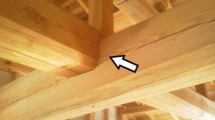Abstract
This study was conducted to analyze the effect of joint type, and numbers and types of dovetail keys on diagonal tension and compression performance of corner joints in a furniture frame. Joint members were cut from white fir lumber. Butted and mitered joints were constructed with one and two dovetail key(s) with butterfly and H shapes. Joints were glued by polyvinyl acetate (PVAc) and cynoacrylate (CA). Compression capacity of joints was higher than diagonal tension. Mitered joints were stronger than butted ones. Butterfly dovetail keys were superior to H shape keys. Double keys performed better than single key. Experimental joints glued with PVAc were stronger than those glued with CA glue and control specimens. In terms of strength, butterfly dovetailed joints were comparable with doweled joints.
Similar content being viewed by others
References
Altun S, Burdurlu E, Kilic M. 2010. Effect of adhesive types on the bending moment capacity of miter frame corner joints. BioResources, 5(3): 1473–1483.
American Society of Testing and Materials (ASTM). 1999. Test methods for specific gravity of wood and wood-base materials. ASTM D 2395. Philadelphia, PA: ASTM.
American Society of Testing and Materials (ASTM). 1999. Test methods for small clear specimens of timber. ASTM D 143-09. Philadelphia, PA: ASTM.
Atar M, Keskin H, Peker H, Ustundag A, Togay A, Candan Z. 2010. Impacts of different joint angles and adhesives on diagonal tension performances of box-type furniture. BioResources, 5(1): 343–355.
Atar M, Ozcifci A, Altinok M, Celiket U. 2009. Determination of diagonal compression and tension performances for case furniture corner joints constructed with wood biscuits. Materials & Design, 30(3): 665–670.
Eckelman CA, Lin FC. 1997. Bending strength of corner joints constructed with injection molded splines. Forest Products Journal, 47(4): 89–92.
Eckelman CA, Rabiej R. 1985. A comprehensive method of analyze of case furniture. Forest Products Journal, 35(4): 62–68.
Erdil YZ, Kasal A, Eckelman CA. 2005. Bending moment capacity of rectangular mortise and tenon furniture joints. Forest Products Journal, 55(12): 209–213.
Jones A, Lutes R. 1993. Handbook of joinery. New York, USA: Sterling Press.
Kasal A, Şener S, Belgin CM, Efe H. 2006. Bending strength of screwed corner joints with different materials. G.U. Journal of Science, 19(3): 155–161.
Kilic M, Burdurlu E, Altun S, Berker UÖ. 2009. The bending moment capacities of mitre frame corner joints with dovetail fittings. Wood Research, 54(3): 79–88.
Norvydas V, Juodeikienė I, Minelga D. 2005. The influence of glued dowel joints construction on the bending moment resistance. Materials Science, 11(1): 36–39.
Ozkaya K, Burdurlu E, Ilce AC, Ciritcioglu HH. 2010. Diagonal tensile strength of an oriented strand-board (OSB) frame with dovetail corner joint. BioResources, 5(4): 2690–2701.
Tankut AN. 2001. Design of panel and panel on frame bookshelves and cabinets. Dissertation, University of Purdue.
Tankut AN. 2005. Optimum dowel spacing for corner joints in 32 mm cabinet construction. Forest Products Journal, 55(12): 100–104.
Tankut AN, Tankut N. 2009. Investigations the effects of fastener, glue, and composite material types on the strength of corner joints in case-type furniture construction. Materials & Design, 30(10): 4175–4182.
Tankut AN, Tankut N. 2010. Evaluation the effects of edge banding type and thickness on the strength of corner joints in case-type furniture. Materials & Design, 31(6): 2956–2963.
Tankut N. 2007. The effect of adhesive types and bond line thickness on the strength of mortise and tenon joints. International Journal of Adhesion and Adhesives, 27(6): 493–498.
Tas HH. 2010. Strength properties of L-profiled furniture joints constructed with laminated wooden panels. Scientific Research and Essays, 5(6): 545–550.
Williamson T. 2002. APA Engineered wood handbook. McGraw-Hill Professional.
Zhang JL, Eckelman CA. 1993. Rational design of multi dowel corner joints in case construction. Forest Products Journal, 43(11–12): 52–58.
Zhang JL, Eckelman CA. 1993. The bending moment resistance of single-dowel corner joints in case construction. Forest Products Journal, 43(6): 19–24.
Author information
Authors and Affiliations
Corresponding author
Rights and permissions
About this article
Cite this article
Dalvand, M., Ebrahimi, G., Haftkhani, A.R. et al. Analysis of factors affecting diagonal tension and compression capacity of corner joints in furniture frames fabricated with dovetail key. Journal of Forestry Research 24, 155–168 (2013). https://doi.org/10.1007/s11676-013-0336-y
Received:
Accepted:
Published:
Issue Date:
DOI: https://doi.org/10.1007/s11676-013-0336-y




